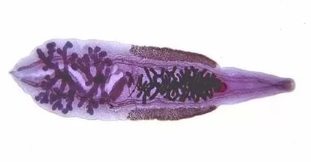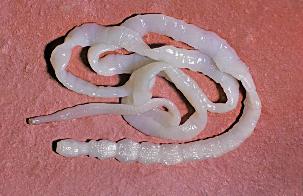
Helminthiases is one of the most common diseases among the children and the adults. The human body parasites in different species of worms. There is an opinion, far from medicine, in which the worms affect the digestive tract, in fact, worms can parasitize almost all the internal organs – the liver, the lungs, the heart, the brain, the head and the muscle tissue to the subcutaneous tissues and the eye. The article about the worm's people.
Classification
There is a huge number of worms which can affect humans, some of the most common of them. Most worms belong to the 3 groups, trematodes, cestodes or nematodes.
Blight is a class of parasitic worms of flat-shaped, approximately 40 species of worms that affect man. The most common:
- cat or Siberian Fluke (causes opisthorchiasis);
- Schistosoma (which schistosomiasis).
Cestodes – tape worms are flat. The representatives of cestodes have no digestive system. Most people staggering:
- beef tapeworm (beef-tapeworm-infection causes);
- pork tapeworm (which, cysticercosis);
- Echinococcus (hydatid cyst causing).
The Nematoda of the yarn, which is primarily abdominal. Common helminthiasisok affecting people:
- the pinworms;
- cylindrical worm;
- the escape.
Worms in humans — signs of the image (mostly the worms affect the digestive system, so nausea, vomiting, diarrhea or constipation, intestinal obstruction, unexplained weight loss, loss of appetite or excessive hunger):
Cat or Siberian Fluke

Cat or Siberian Fluke is a small parasite, lanceolate, the group of liver flukes. The pathogen of the disease opisthorchiasis. Long cat Fluke reaches 8-18 mm wide, 1,2-2 mm. the Parasite develops in the body, the two hosts, both intermediate and final. Intermediate hosts – molluscs, fish, the carp, the ultimate man.
Together with the stool of the infected person or animal, the eggs get into freshwater reservoirs, where they consume the shellfish. The body of a mollusc egg reaches the infectious stage – cercaria, cercaria leave the mollusc, and the body in the cyprinid fish, or their body eating fish and shellfish. The body of the fish the parasite develops to the meta-cercaria in the cyst reaches the size of 0.17-0.21 mm.
When eating contaminated fish infected people, the body meta-cercaria leave the cysts, the stomach and intestine through the liver and bile ducts. These bodies continue to parasite, and 10 to 12 days to reach the Mature stage begin to eggs. The human body cat Fluke can be a parasite up to 10-20 years.
Shistosoma
Schistosoma – blood flukes. This is a flat dioecious helminths, long, 4-20 mm, width 0.25 mm. Body shistosoma equipped with 2 suckers – oral and ventral, they are close to each other. The women of the Schistosoma longer, but thinner than the males. The body of the man is a longitudinal groove, he's holding the woman. The egg is 0.1 mm in diameter, oval-shaped, on the surface of the poles a big spike.
Human worms Schistosoma the role of the final host choice of the people, the creatures are parasites in the small blood vessels of the large intestine, abdominal cavity, uterus, bladder. Worms of blood, partly absorbed nutrients through the cuticle. Eggs Schistosoma transported to the intestine and bladder, where they Mature, or is excreted in the feces or the urine. The fresh water the egg comes out the larva, the intermediate stations – molluscs. The body of the mollusc meta cercaria cercaria develop in 4-8 weeks.
Beef tapeworm

Beef-tapeworm – band parasite causing the disease in beef-tapeworm-infection. This is a huge helminths, are able to grow to 3-12 meters long. The body of the parasite is a small head with a diameter of 3 mm, the neck, approximately 1000 segments. After entering the human body with unprocessed infected meat, the tapeworm attaches to the intestinal wall using 4 suction cups.
The hermaphrodite segments to deposit the eggs on the helminthiasisok, a year, a person lays up to 600 million eggs. Like worms in humans, parasitic in the intestine of 20 years or more, if not timely treatment.
Pork tapeworm
Pork tapeworm, like a bull, the body, 4 suckers, but in addition the body of the helminthiasisok has a dual rim hooks. Reaches two to three feet long. A pork tapeworm, before the ovary, on both sides of the uterus 7 to 12 branches. Typical helminthiasisok – ability of the segments crawl out of the anus. After the appearance of the shell becomes dry and broken, so the external environment helminthiasisok eggs. Intermediate host tapeworm pig, human.
The main host was a man. Intestinal parasite among humans, the pork tapeworm, is a helminthiasisok in the intestine of the patient, where they lay eggs. The infection occurs in the use of invasive meat.
Echinococcus
The pathogen echinococcosis, length reaches 3-5 mm. The head, which has four suckers, two wheels, hooks, three or four segments. The last segment of a developed reproductive system. Intermediate host – cattle, or humans, the definitive host – dog, wolf. Infection occurs in oral route.
Echinococcus enters the intestine, where the eggs appear in the larvae. Using the hooks, the larvae penetrate into the portal vein, where the blood spread to the liver, lungs, muscle tissue.
Pinworms

The rectum worm – thread, enterobiasis pathogens, the so-called disease of dirty hands. To a greater extent tapeworm infection-prone children. The infection occurs orally, and the contact-household. To detect these worms in the stool.
The females helminths diagnosed, the genus reach length of 5-10 mm, the male – to 3 millimeters. Shape diagnosed, fusiform milky white. At the end of the body females are slightly pointy. The adult worms are parasitic in the lower small intestine and colon of man, to be attached to the wall, use the head, blisters. In order that the eggs of the female are diagnosed, you pass to the rectum, crawl out and lay eggs in anal area, then die. The eggs become infectious after 4-6 hours. The duration of the tapeworm life – a month or two.
Cylindrical worm
The industry – still a few representatives of the class of yarn, parasites, the causative agents of ascariasis. This is the helminths yellowish – pink, an elongated, spindle-shaped, dioecious. Female ascarids can grow up to 20-40 cm, males reach length of 15-25 cm. Every day is a grown woman in the industry is determined by more than 200 thousand eggs, which, together with stool people the environment, where the after 12-14 days became invasive.
In the human body parasites in the gastro-intestinal tract, stationary, primarily in the small intestine. Full cycle of development of the infectious eggs to Mature stage takes about 3 months.
The escape
Escape from – round worm, which trihozefalez. The worms with a thin brown worm with a thin, threadlike anterior and a rounded posterior end. Women's running women's 3.5-5.5 cm, males up to 3-4,5 cm. Larvae, worms, human or localized to the caecum, where it is a parasite, the stage of puberty, there to lay their eggs. A huge invasion of helminths to the colon, including the rectum.
Every day the women's escape is determined by the 3,5 thousand eggs. Helminthiasisok eggs in a barrel-shaped, covered with a thick brown shell, the poles found colorless "caps". The eggs get into the soil and the faeces of the primary host, under favorable conditions they can retain invasive properties, a maximum of two years. Duration of parasite of the human intestine 5-7 years.






































